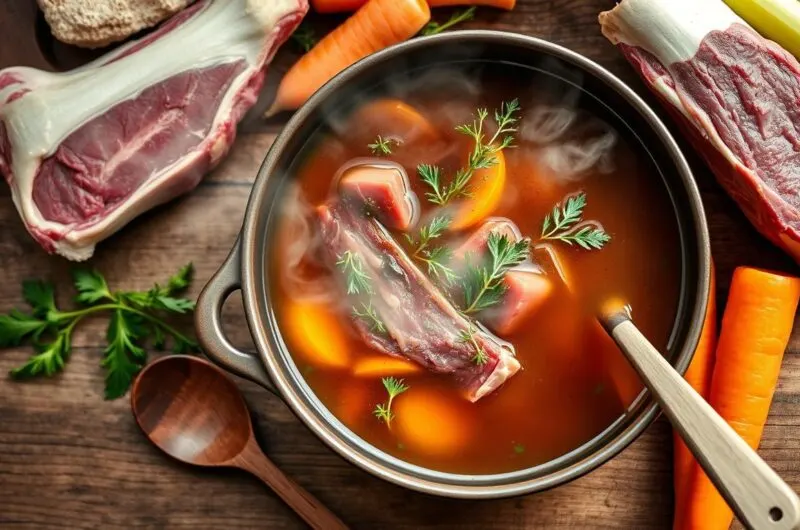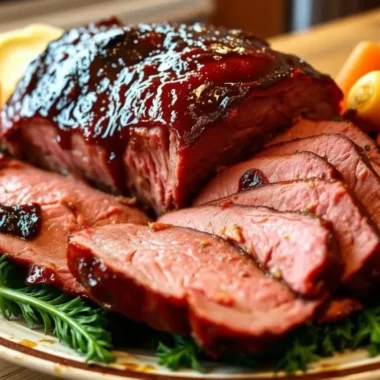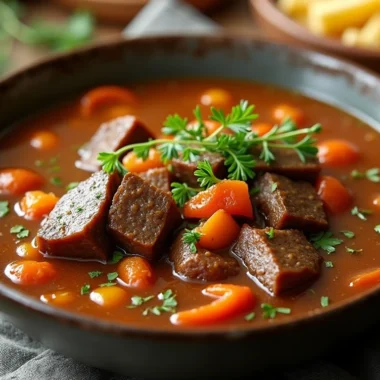As morning light enters the kitchen, the smell of beef bones fills the air. It reminds me of the nourishment in this simple liquid. Homemade beef bone broth is more than a tasty treat. It’s a key to a healthier, more vibrant life. We’ll dive into its history, benefits, and how to make it at home.
Beef bone broth has been a family tradition for generations. It’s made by simmering bones and veggies for hours. This unlocks vitamins, minerals, and compounds that boost our health. It helps with digestion and supports our joints.
Table of Contents
What is Beef Bone Broth?
Beef bone broth is a liquid packed with nutrients. It’s made by simmering grass-fed beef bones, veggies, and herbs for 12-24 hours. This collagen-rich broth is full of amino acids, minerals, and other health benefits.
A Nutritional Overview
Beef bone broth is known for its nutritional value. It’s a great source of collagen, which is key for our skin, joints, and connective tissues. It also has important amino acids like glycine, proline, and arginine, which are crucial for our body’s functions.
Key Ingredients
- Grass-fed beef bones: These bones are the base of the broth, adding minerals like calcium, magnesium, and phosphorus.
- Apple cider vinegar: It helps pull more nutrients from the bones during the simmering.
- Aromatic vegetables: Carrots, onions, and celery add flavor and extra vitamins and minerals.
- Herbs and spices: Seasonings like black peppercorns, bay leaves, and thyme make the broth taste and smell better.
The long cooking time is key. It lets the bones and connective tissues break down. This releases their collagen-rich goodness into the broth.
Benefits of Consuming Beef Bone Broth
Beef bone broth is packed with health benefits. It’s full of collagen, which is good for your joints and skin. The amino acids glycine and proline help your gut and digestion.
It also has important minerals like calcium, magnesium, and phosphorus. These minerals are easy for your body to absorb.
Rich in Nutrients
One cup of beef bone broth has about 50 calories, 0.5 grams of fat, and 9 grams of protein. It’s also rich in electrolytes like potassium and sodium. These help your nerves and muscles work right.
The collagen in bone broth can make your joints healthier. It protects tendons and ligaments.
Digestive Health Boost
Bone broth may help reduce inflammation and support your gut health. The gelatin in it helps with digestion by binding with water. Studies show that glycine and proline can boost your gut’s immunity and diversity.
If you want to improve your joint health, skin, or gut function, try bone broth benefits, gut-healing broth, and collagen-rich broth. They’re tasty and good for you.
How to Choose the Best Bones
Choosing the right bones is key to making a delicious and healthy beef bone broth. Look for bones that are full of collagen and marrow. This is because they are packed with good nutrients. For the best broth, mix different bones like knuckle bones, marrow bones, and joints.
Types of Bones to Use
- Grass-fed beef bones: These are top picks because they have more nutrients than regular beef bones. Choose bones from cows that eat grass.
- Soup bones: Also known as marrow bones, these are great for broth. They add a creamy texture and lots of collagen.
- Knuckle and joint bones: These bones are rich in cartilage and connective tissue. They release nutrients like glucosamine and chondroitin into the broth.
Where to Buy Quality Bones
The best place to find quality bones is at local butcher shops, farmer’s markets, or from farms that sell beef. You can also ask your butcher for “soup bones” or “marrow bones” when buying a side of beef. These places offer the freshest and most nutrient-rich bones for your broth.
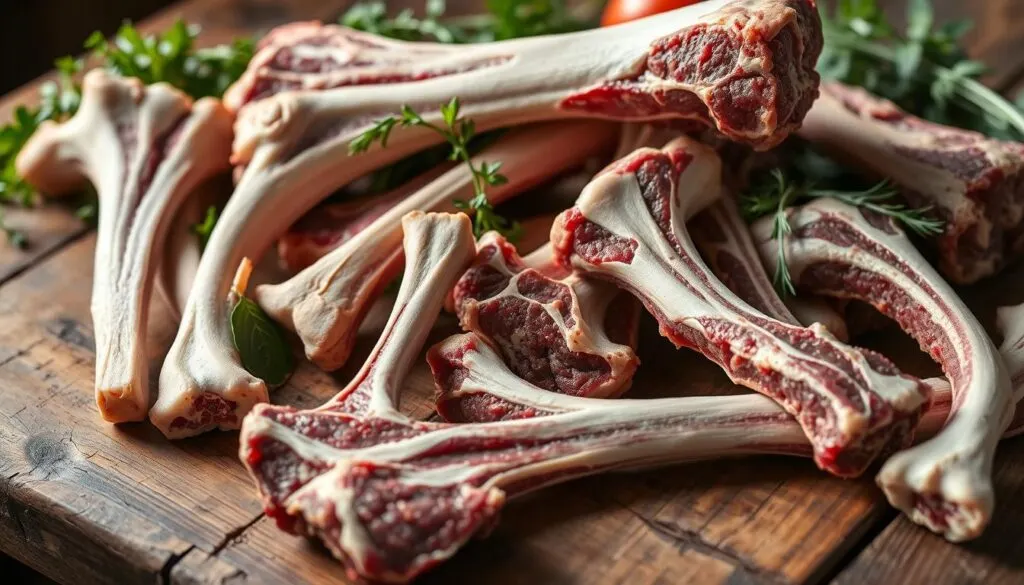
“The best bones for bone broth are those that are rich in collagen and marrow, as they provide a wealth of beneficial nutrients.”
Essential Tools for Making Bone Broth
To make delicious bone broth at home, you need a few key tools. You’ll need a large stockpot, slow cooker, or Instant Pot. Each has its own benefits for making bone broth.
Slow Cooker vs. Instant Pot
A slow cooker is great for long, low-heat simmering. It extracts the most flavor and nutrients from bones. An Instant Pot, however, makes bone broth faster and easier.
Necessary Kitchen Utensils
- Fine-mesh strainer: Essential for separating the broth from the solid bone and vegetable matter.
- Large bowl: Needed to collect the strained bone broth.
- Ladle: Useful for portioning the bone broth into storage containers.
- Storage containers: Glass jars or BPA-free plastic containers are ideal for refrigerating or freezing your bone broth.
- Roasting pan (optional): If you choose to roast the bones before simmering, a roasting pan will come in handy.
With the right tools, you can make nutrient-rich bone broth. You can use a slow cooker or Instant Pot. The right bone broth equipment makes making homemade bone broth easy.
Step-by-Step Guide to Making Beef Bone Broth
Homemade beef bone broth is full of nutrients and can be used in many ways. To make a delicious and healthy broth, just follow these easy steps:
Preparing the Bones
Begin by roasting the bones in the oven at 400°F for 20-30 minutes. This step boosts the flavor and aroma of the broth. After roasting, put the bones and any veggies you like (like onions, carrots, and celery) in a big pot or slow cooker. Add a few tablespoons of apple cider vinegar too.
Cooking Time and Temperature
- For stovetop cooking, fill the pot with water and bring it to a boil. Then, lower the heat and simmer for 12-24 hours, depending on the bone size. Smaller bones might need 6-12 hours, while bigger ones could take up to 24 hours or more.
- If you’re using a slow cooker, cook the broth on low for 18-24 hours. Longer cooking time lets the bones release more nutrients and flavor, making the broth rich and nourishing.
Whether you’re cooking on the stovetop or in a slow cooker, skim off any foam or impurities that rise to the top. This keeps your broth clear and clean-tasting.
After the broth is done cooking, strain it through a fine-mesh sieve to get rid of the bones and veggies. Now you have your homemade beef bone broth, ready to be stored and enjoyed.
Flavoring Your Bone Broth
Make your homemade bone broth taste better by adding herbs, spices, and veggies. This not only boosts the flavor but also gives it a special twist.
Common Herbs and Spices
Begin by simmering your bone broth with bay leaves, peppercorns, garlic, and ginger. These classic flavors are a great start for your bone broth seasoning. Try adding turmeric, star anise, or cinnamon for a unique taste.
For a fresh touch, add parsley, thyme, or rosemary in the last 30 minutes. This keeps their flavors and scents intact.
Adding Vegetables for Extra Flavor
- Onions, carrots, and celery add depth and complexity to your bone broth ingredients.
- Roasting these veggies before adding them caramelizes their sugars, boosting the flavor.
- Try mushrooms, fennel, or tomatoes for a customized bone broth.
Don’t add salt until after cooking to avoid over-seasoning. This lets you adjust the salt to your liking.
“The key to a delicious bone broth is in the seasoning. Experiment with different herbs, spices, and vegetables to find your perfect flavor combination.”
Storing Your Beef Bone Broth
Keeping your homemade beef bone broth fresh is key. It’s great for daily sips or as a base for soups. Knowing how to store it right ensures you enjoy its full nutritional benefits.
Freezing Tips
Freezing is a top choice for long-term storage. Homemade beef broth can last about 6 months in the freezer. Make sure to leave space in containers for expansion. You can use airtight containers, resealable bags, or ice cube trays for easy portions.
- Freeze in individual servings or small batches for easy thawing and reheating.
- Choose freezer-safe containers or bags to avoid freezer burn and keep the flavor.
- Thaw in the fridge overnight or reheat from frozen on the stovetop.
Shelf Life in the Refrigerator
In the fridge, your homemade broth lasts up to 5 days. Store-bought broth might last about 4 days. Always check for color, smell, and texture changes. Discard if it shows mold, bad smells, or odd particles.
Proper storage, whether freezing or refrigerating, extends the life of your beef bone broth. Mastering storage lets you enjoy its health benefits for months.
Creative Ways to Use Beef Bone Broth
Beef bone broth is a versatile ingredient that can elevate many dishes. It adds flavor and nutrients to your cooking. It’s also great for refreshing summer recipes.
Soups and Stews
Beef bone broth makes soups and stews more nutritious and flavorful. It’s perfect for French onion soup or beef stew. Even recipes like cheeseburger casserole benefit from it.
Cooking Grains or Legumes
Use beef bone broth instead of water when cooking grains like rice or quinoa. It adds a savory taste and extra minerals. It’s also good for cooking legumes, making them a nutrient-rich base for dishes.
“Bone broth is nature’s highest source of dietary collagen, containing essential minerals, electrolytes, gelatin, amino acids, glucosamine, and chondroitin sulfate.”
Bone broth is refreshing in warm weather. Chill it or freeze it for a protein-rich drink. It’s great in smoothies, cocktails, and mocktails. You can also make popsicles, ice cream, and chilled soups for BBQs.
Using beef bone broth in your cooking and summer recipes is a smart choice. It offers health benefits and adds flavor to your dishes.
Health Considerations
Bone broth is usually safe to eat, but it’s key to watch out for allergies, sensitivities, and health issues. It can be a great addition to your diet. Yet, it’s wise to talk to a healthcare expert or a registered nutritionist before adding it to your meals.
Allergies and Sensitivities
Some people might react to the glutamates in bone broth. Those with histamine intolerance should be careful too. If you have food allergies or sensitivities, start with a small amount of bone broth and watch how your body reacts.
Consulting with a Nutritionist
It’s a good idea to talk to a registered nutritionist or healthcare professional before adding bone broth to your diet. This is especially true if you have health conditions or dietary restrictions. They can help you safely include bone broth in your meals and answer any questions about its bone broth health benefits or bone broth nutrition.
Even though bone broth is generally bone broth safe for many, it’s best to be cautious. Working with a qualified professional ensures it fits your health needs.
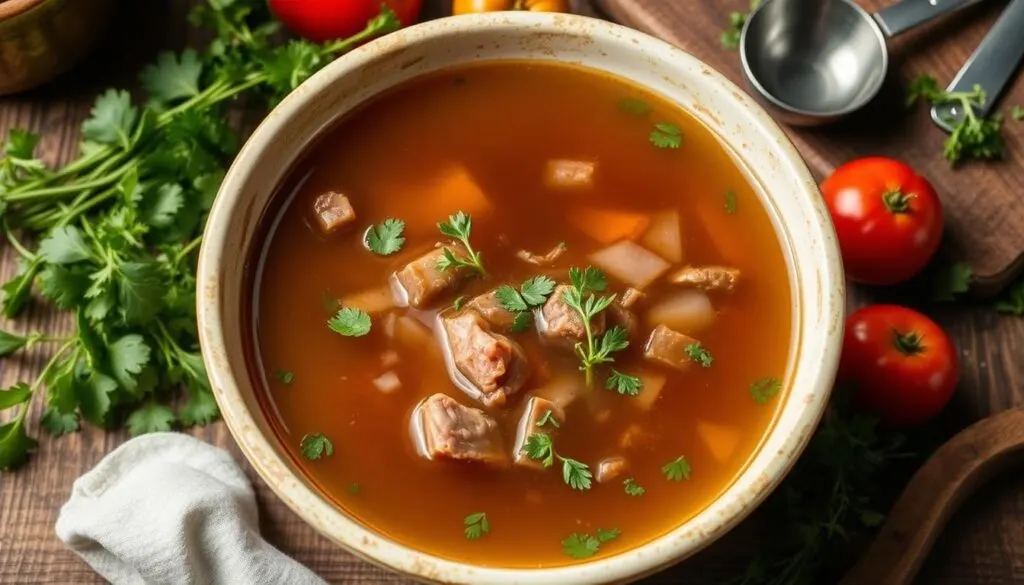
Frequently Asked Questions about Bone Broth
Bone broth is getting more popular, and people have questions about it. Let’s look at some common questions about this healthy drink.
How Long Does Bone Broth Last?
Your homemade beef bone broth can last 5-7 days in the fridge. Or, you can freeze it for up to 6 months. Make sure to store it in a tight container, like a mason jar or freezer-safe bag.
This keeps the flavor in and stops it from getting old. To use it, just thaw it in the fridge or heat it up on the stovetop or in the microwave.
Can You Drink Bone Broth Daily?
Drinking bone broth every day is safe and good for most people. It’s full of nutrients that help your gut, joints, and overall health. Start with 8 ounces a day and see if you want more.
But remember, it’s not the only thing you should eat. Bone broth is great, but it’s part of a bigger diet. Eating a variety of foods is best for your health.
Conclusion: Enjoying Beef Bone Broth
Adding bone broth to your daily routine is easy and beneficial. Start with a warm cup in the morning. Or, use it in soups, stews, and to cook grains and legumes. Its versatility makes it a must-have in your kitchen.
Incorporating It into Your Diet
Drinking bone broth is a simple way to get more nutrients. It’s full of minerals, amino acids, and collagen. These can help your gut, joints, and overall health. Try different homemade bone broth recipes to find your favorite taste.
Sharing with Family and Friends
Sharing bone broth with family and friends is a kind gesture. It helps spread the word about its health bone broth benefits. Teach them about its nutritional value and how to use it in their bone broth lifestyle. Enjoying bone broth together can strengthen bonds and promote health in your community.
FAQ
How long does beef bone broth last?
Beef bone broth stays good in the fridge for 5-7 days. You can freeze it for up to 6 months.
Can you drink beef bone broth daily?
Drinking beef bone broth every day is usually safe for most people. It might help your gut, joints, and overall health. Start with a little and see how you feel before drinking more.
Are there any health considerations with beef bone broth?
Most people can safely drink beef bone broth. But, some might be sensitive to glutamates. If you have histamine intolerance, be careful.
Before adding bone broth to your diet, talk to a doctor or nutritionist. This is especially true if you have health issues or special diets.
Source Links
- Nourishing Beef Bone Broth – https://www.raisinggenerationnourished.com/2014/02/nourishing-beef-bone-broth/
- How to Make Beef Bone Broth – Simple Life Mom – https://simplelifemom.com/how-to-make-beef-bone-broth/
- What’s the Difference Between Stock and Bone Broth? – https://www.tasteofhome.com/article/the-difference-between-stock-and-bone-broth/?srsltid=AfmBOorC35y5vpRn2O3VtGmf_YAcCpVfC1o-CaJf1DWCqw6MPoj2-cGq
- Reduced Sodium Beef Bone Broth – https://www.kettleandfire.com/products/reduced-sodium-beef-bone-broth?srsltid=AfmBOoqBU5JYBaYFmxAj8as5p8FEnj1HpjTYxHfO2S0vR21nal2yXdTP
- Bone Broth: Benefits, How To Make and Nutrition – https://health.clevelandclinic.org/bone-broth-benefits
- Top 5 health benefits of bone broth – https://www.bbcgoodfood.com/health/nutrition/health-benefits-of-bone-broth
- Bone broth is going viral for anti-aging and weight loss benefits. Does it work? Experts explain – https://www.today.com/health/diet-fitness/is-bone-broth-good-for-you-rcna134088
- We Tasted the Best Bone Broths for Cooking, Sipping, or Both! – https://www.thespruceeats.com/best-bone-broths-4843938
- We Taste-Tested 17 Bone Broths—These Are the Best for Flavor and Texture – https://www.eatingwell.com/best-bone-broths-8418152
- These 10 Dietitian Approved Bone Broths Can Help Support Skin, Joint and Gut Health – https://www.verywellfit.com/best-bone-broths-4691175
- How to Make Bone Broth: Instant Pot, Crockpot & Stove | Wholefully – https://wholefully.com/bone-broth/
- How to Make Bone Broth – https://thesurvivalmom.com/how-to-make-bone-broth/
- Easy Nourishing Beef Bone Broth Recipe (slow Cooker & Stovetop) – Good Food Baddie – https://goodfoodbaddie.com/easy-beef-bone-broth-recipe/
- The Right Way to Make Bone Broth, According to Experts – https://www.marthastewart.com/how-to-make-bone-broth-7479697
- Bone Broth Recipe (Easy, 3 Ways) – Wholesome Yum – https://www.wholesomeyum.com/bone-broth/
- How To Make Bone Broth Taste Better: 7 Beginner To Expert Hacks – https://www.barebonesbroth.com/blogs/blog/how-to-make-bone-broth-taste-better?srsltid=AfmBOopBmO7YwUb9QoOzQqXZI41Y4mPuT0gMHjqO7oiIa0RHOORMJdEl
- How To Make Bone Broth Taste Better: Delicious Add ins to Satisfy Your Cravings – https://bluebirdprovisions.co/blogs/news/how-to-make-bone-broth-taste-better?srsltid=AfmBOoogWzsZCWuOlrMyKzBLkLbJ3tLkjGhO70CzLdsiMAMs5VWV_CoV
- How Long Does Beef Broth Last in the Fridge? – https://feedmebetter.com/how-long-does-beef-broth-last-in-the-fridge/
- How to Freeze Bone Broth (Any Type) – https://practicalselfreliance.com/freeze-bone-broth/
- 26 Recipes To Use Up The Rest Of That Beef Broth In Your Pantry – https://www.southernliving.com/recipes-with-beef-broth-8546375?srsltid=AfmBOoq8LRJNMb3gn2Zc1YrTL_2hFNcyRGWtuz7kaslHfcX8IDKlW29-
- 15 Ways to Use Bone Broth in the Summer (+ 35 Bone Broth Recipes!) – https://www.barebonesbroth.com/blogs/blog/ways-to-use-bone-broth-in-the-summer?srsltid=AfmBOoqVKT307uhF94n1YiWN2HafdBTLzRDwtpTMNVomUCHCsCZuTzqw
- Bone Broth: The Benefits and the Risks – https://zoe.com/learn/bone-broth
- 5 Potential Health Benefits of Drinking Bone Broth Every Day – https://www.verywellhealth.com/is-bone-broth-good-for-you-8725922
- What Happens to Your Body When You Drink Bone Broth Every Day – https://www.eatingwell.com/is-bone-broth-healthy-8584395
- What Is Bone Broth? | D’Arcy’s Meat Market – https://darcysmeats.ca/blogs/blog/bone-broth-faqs-what-is-bone-broth?srsltid=AfmBOoochk6E8Q5YFfxeUDbQgqa_vT4szOiQuq0zAnUg-c28f3-5eO0L
- FAQ – https://boulderbroth.com/pages/faq
- FAQ – Magic Broth – https://magic-broth.com/faq/
- The Timeless Benefits of Bone Broth (+ Recipes!) – https://heartandsoil.co/blog/the-timeless-benefits-of-bone-broth/
- How to Make Beef Broth 3 Ways / Should I use a Slow-Cooker, Instant Pot or Stove Top Method? – Our Liberty House – https://www.ourlibertyhouse.com/blog/beef-broth-3-ways
- Healthy & Nutritious Bone Broth Recipe For Older Adults — More Life Health – Seniors Health & Fitness – https://morelifehealth.com/articles/bone-broth
Did You Try This Recipe ?
There are no reviews yet. Be the first one to write one.

